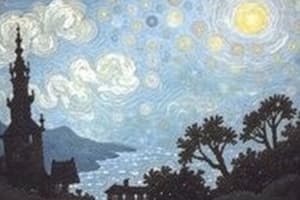Podcast
Questions and Answers
How does syntax function within a language?
How does syntax function within a language?
- It organizes the lexicon into new words
- It arranges words into coherent sentences (correct)
- It modifies the lexicon's vocabulary
- It conveys meaning through phonemes
Which of the following is NOT a characteristic of language as described?
Which of the following is NOT a characteristic of language as described?
- It allows sharing of thoughts and concepts
- It consists of sounds, signs, and symbols
- It serves to transmit verbal information
- It is solely a form of non-verbal communication (correct)
What is the primary function of internal (inner) speech?
What is the primary function of internal (inner) speech?
- To assist in thinking and problem-solving (correct)
- To enhance oral expressiveness
- To replace written communication
- To communicate with others verbally
How does psycholinguistics relate to the study of language?
How does psycholinguistics relate to the study of language?
Which hemisphere of the brain is more associated with linguistic influences on perception?
Which hemisphere of the brain is more associated with linguistic influences on perception?
What is the primary function of language, according to the content?
What is the primary function of language, according to the content?
Which statement accurately reflects the relationship between speech and language?
Which statement accurately reflects the relationship between speech and language?
What does priming refer to in the context of conversation?
What does priming refer to in the context of conversation?
How does written speech differ from oral speech?
How does written speech differ from oral speech?
What is the key feature of dialogue speech?
What is the key feature of dialogue speech?
What is typically the first stage of language development in infants?
What is typically the first stage of language development in infants?
Flashcards are hidden until you start studying
Study Notes
Language Overview
- Language is a cognitive function involving human sounds, written signs, and symbols for processing and transmitting verbal information.
- While language is a communication tool, not all communication qualifies as language; other species use body language, odors, and vocalizations for interaction.
- Many argue that language is a defining trait that sets humans apart from other animals.
Components of Language
- Essential components of language include lexicon (vocabulary) and grammar (rules for conveying meaning).
- Phonemes are basic sound units, differing between languages, and combine to form morphemes, the smallest meaning units.
- Semantics and syntax are crucial for constructing language; semantics derives meaning, while syntax organizes words into sentences.
- Language allows for flexible communication of concrete and abstract concepts, facilitating a wide variety of exchanges, from daily conversations to complex ideas.
Language Development
- Children learn language effortlessly and quickly compared to adults, highlighting a biological predisposition for language acquisition.
- Noam Chomsky criticized behaviorist views (e.g., Skinner) asserting that language development follows a universal pattern across cultures.
- A critical period exists for language acquisition, making early childhood the optimal time to learn languages.
- Infants can initially discriminate all phonemes but narrow this ability to those in their immediate linguistic environment by around one year.
Stages of Language Acquisition
- The babbling stage occurs in early infancy, characterized by repeated single syllables, often not intended for communication.
- First words typically emerge between 1-18 months, with children initially using one-word utterances that carry significant meaning.
- As vocabulary expands, children begin forming simple sentences and exhibit an understanding of grammatical rules, evidenced by overgeneralizations.
Language and Thought
- Meaningful language correlates with culture; the words we use shape our thoughts.
- Sapir and Whorf proposed that language determines thought, suggesting limitations in conceptualizing ideas based on linguistic frameworks.
- Linguistic determinism posits that language both reflects and restricts mental processes and cross-cultural understanding.
- Research indicates that while language influences perception, cognitive abilities remain intact across different linguistic backgrounds.
Communication Dynamics
- Successful conversation relies on common ground between speaker and listener, facilitating understanding and continuity.
- Audience design affects communication; speakers adjust references based on the listener's familiarity with the subject.
- Conversational exchange requires alignment and coordination, with participants often mirroring linguistic phrases and speech patterns.
Types of Speech
- Language is a system of symbols used for communication, while speech is an individual's manifestation of that language.
- External speech includes oral and written forms, with oral speech characterized as monologue or dialogue.
- Written speech relies on grammatical structure without immediate feedback from listeners; internal speech helps with personal thought formulation.
Psycholinguistics
- Psycholinguistics studies the relationship between language, cognition, and communication processes.
- Language processing encompasses reading, writing, speaking, and listening, illuminating how we translate words into meaning.
- Language acquisition explores how children learn language structures and vocabulary shaped by their environment and social context.
- Special circumstances in language development consider the impact of disabilities or neurological factors on language capabilities.
- The study of brain correlates addresses language's evolutionary background and differentiates human communication abilities from non-human animals.
Studying That Suits You
Use AI to generate personalized quizzes and flashcards to suit your learning preferences.




